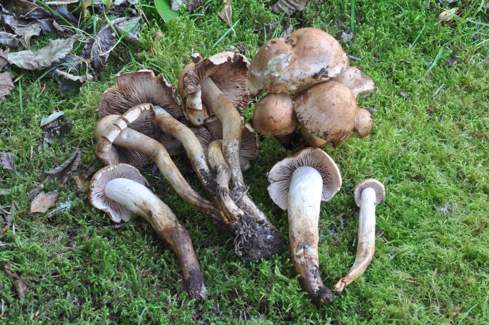 Hebeloma angelesiense (Photo: N. Siegel)
Hebeloma angelesiense (Photo: N. Siegel)Taxonomy
Full name: Hebeloma angelesiense A.H. Sm., V.S. Evenson & Mitchel, The Veiled Species of Hebeloma in the Western United States: 53 (1983)Genus: Hebeloma
Section: Hebeloma
Subsection: Hebeloma
Types: UNITED STATES: Washington: Clallam, Mt Angeles, Olympic National Park (approx. 47.9955°N, 123.4653°W, alt. approx. 1950 m a.s.l.) in boreal woodland, 21 Sep. 1941, A.H. Smith (17096) (Holotype. herbarium acc. no. MICH 10729, HJB1000313).
Heterotypic synonyms:
- Hebeloma indecisum A.H. Sm., V.S. Evenson & Mitchel, The Veiled Species of Hebeloma in the Western United States: 145 (1983)
- Hebeloma pseudostrophosum A.H. Sm., V.S. Evenson & Mitchel, The Veiled Species of Hebeloma in the Western United States: 47 (1983)
- arrow_drop_downarrow_drop_upEtymology
- arrow_drop_downarrow_drop_upOriginal diagnosisPileus 2-6 cm latus, demum plano-umbonatus, viscidus, cinnamomeus deinde argillaceus, ad marginem avellaneus, fibrillosus deinde glabrescens. Odor et gustus raphaninus. Lamellae latae, confertae, adnatae avellaneae demum subcinnamomeae et brunneomaculatae. Stipes 5-8 cm longus, 8-12 mm crassus, deorsum attenuatus, brunnescens, lacerate fibrillosus. Velum bicoloratum (argillaceum et albidum). The Veiled Species of Hebeloma Sporae 7-9.5 x 5-6 μm, ovoideae vel obscure inequilaterales, subdextrinoideae. Cheilocystidia 40-60 x 4-5 μm, ventricosa vel filamentosa.
- arrow_drop_downarrow_drop_upEnglish translationPileus 2-6 cm broad, finally applanate-umbonate, viscid, cinnamon then argillaceous, hazel brown on the margin, fibrillose later becoming glabrous. Smell and taste raphanoid. Lamellae broad, crowded, adnate, hazel brown then pale cinnamon and spotted brown. Stipe 5-8 cm long, 8-12 mm thick, attenuate downwards, discolouring brown, jaggedly fibrillose, Veil bicoloured (argillaceous and whitish). Spores 7-9.5 x 5-6 μm, ovoid or indistinctly inequilateral, subdextrinoid. Cheilocystidia 40-60 x 4-5 μm, ventricose or filamentous.
References
Description
- arrow_drop_downarrow_drop_upThresholds
Description of Hebeloma angelesiense based on 20 collections
- arrow_drop_downarrow_drop_upMacroscopic descriptionPileus: (20) 29–117 (160) mm diameter; shape often convex or umbonate, occasionally broadly umbonate, rarely weakly umbonate; characters often remains of universal veil, occasionally hygrophanous or spotting; margin characters often involute, occasionally smooth or wavy, rarely fibrillose, overhanging pileus or reflexed; viscosity tacky when moist; colour variation often unicolour, occasionally two color; colour at centre occasionally dark fawn or cinnamon, rarely yellowish brown or orange-brown.
Lamellae: attachment often emarginate, occasionally adnate, rarely adnexed; maximum depth up to 6 mm; number of complete lamellae 60–80; presence of tears absent; white fimbriate edge often weak, occasionally present, rarely absent.
Cortina presence: yes.
Stipe: (40) 51–124 (131) x (5) 6–21 (31) {median} x (5) 6–18 (25) {basal} mm; stipe Q 4.2–13.6; base shape usually tapering, occasionally cylindrical, rarely clavate; floccosity usually fibrillose, often pruinose at apex, rarely floccose; rooting no; thick rhizoids at base absent;
Context: Texture firm; stipe interior usually hollow, occasionally stuffed; stipe flesh discolouring occasionally yes or very strongly, rarely no; slenderness measure 3.5–26.5; smell occasionally odourless or raphanoid, rarely cocoa or earthy; taste occasionally mild or raphanoid, rarely bitter or weakly raphanoid where recorded.
Spore deposit colour: yellowish brown.
Exsiccata characters: Not recorded.
- arrow_drop_downarrow_drop_upMicroscopic descriptionSpores: shape ellipsoid, rarely ovoid; colour in microscope often grey yellow, occasionally brown pale or yellow; guttules usually no, occasionally weak. papilla no; Spore Code: O1 (O2); P0; D0 (D1).
Basidia: (17) 18–35 x 5–8 (9) μm; ave. Q 3.4–4.2; spore arrangement usually 4 spored, rarely variable;
Cheilocystidia: main shape lageniform or ventricose, often cylindrical, rarely pyriform; special features observed often basal thickening or septa, occasionally apical thickening, many collapsed in exsiccata or sparse, rarely bifurcate, geniculate or yellow contents; cheilocystidia ratios: A/M = 0.99–1.19; A/B = 0.60–0.84; B/M = 1.40–1.83.
Pleurocystidia: none seen.
Ixocutis: epicutis thickness (measured from exsiccata) up to 170 μm; ixocutis hyphae width up to 8 μm; ixocutis hyphae encrustation yes; shape of trama elements beneath subcutis cylindrical up to 15 μm wide.
Caulocystidia: Similar to cheilocystidia but larger, up to 150 μm.
- arrow_drop_downarrow_drop_upSpore measurements
- arrow_drop_downarrow_drop_upCheilocystidia measurements
- arrow_drop_downarrow_drop_upHabitat and distributionHebeloma angelesiense's preferred habitat appears to be coniferous woodland. Where only one possible associate was recorded, that associate has always been Pseudotsuga (family Pinaceae). We have additional records where Tsuga, Picea and Abies were recorded as possible associates, but in these cases a number of possible associates were mentioned. Pinaceae was the only recorded family. The growth habit of our collections was often caespitose, occasionally gregarious or scattered and rarely solitary.
According to our current collections, the species is found only in Northern America. On the continent, collections have been found only in the temperate conifer forests WWF biome The World Wildlife Fund (WWF) have divided the world into 867 terrestrial ecoregions. The ecoregion here is estimated by mapping from the GPS coordinates of the collection using data made available by Dinerstein et al (2017). Use this webtool to explore the ecoregions visually or see a full list of current ecoregions on Wikipedia. (Northern California coastal forests (35.0%) and Central-Southern Cascades Forests (30.0%) ecoregions). From collector information, it appears collections have been found in the 1.4 Forest – Temperate (57.1%) and 1.1 Forest – Boreal (42.9%) IUCN habitats We map from the collector's description of the habitat to the International Union for Conservation of Nature (IUCN)'s definition using a standardised set of rules. Please see this page for a full list of IUCN habitats.. Within Northern America we have records from Northwestern U.S.A. (Oregon, Washington and Colorado) and Southwestern U.S.A. (California).
Geographic distribution
Phenology
- arrow_drop_downarrow_drop_upAdditional cited collections